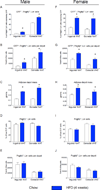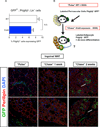Pdgfrβ+ Mural Preadipocytes Contribute to Adipocyte Hyperplasia Induced by High-Fat-Diet Feeding and Prolonged Cold Exposure in Adult Mice
- PMID: 26626462
- PMCID: PMC4749445
- DOI: 10.1016/j.cmet.2015.10.018
Pdgfrβ+ Mural Preadipocytes Contribute to Adipocyte Hyperplasia Induced by High-Fat-Diet Feeding and Prolonged Cold Exposure in Adult Mice
Abstract
The expansion of white adipose tissue (WAT) in obesity involves de novo differentiation of new adipocytes; however, the cellular origin of these cells remains unclear. Here, we utilize Zfp423(GFP) reporter mice to characterize adipose mural (Pdgfrβ(+)) cells with varying levels of the preadipocyte commitment factor Zfp423. We find that adipose tissue contains distinct mural populations, with levels of Zfp423 distinguishing adipogenic from inflammatory-like mural cells. Using our "MuralChaser" lineage tracking system, we uncover adipose perivascular cells as developmental precursors of adipocytes formed in obesity, with adipogenesis and precursor abundance regulated in a depot-dependent manner. Interestingly, Pdgfrβ(+) cells do not significantly contribute to the initial cold-induced recruitment of beige adipocytes in WAT; it is only after prolonged cold exposure that these cells differentiate into beige adipocytes. These results provide genetic evidence for a mural cell origin of white adipocytes in obesity and suggest that beige adipogenesis may originate from multiple sources.
Copyright © 2016 Elsevier Inc. All rights reserved.
Conflict of interest statement
Figures




References
-
- Armulik A, Genove G, Betsholtz C. Pericytes: developmental, physiological, and pathological perspectives, problems, and promises. Dev Cell. 2011;21:193–215. - PubMed
Publication types
MeSH terms
Substances
Grants and funding
LinkOut - more resources
Full Text Sources
Other Literature Sources
Medical
Molecular Biology Databases
Research Materials

